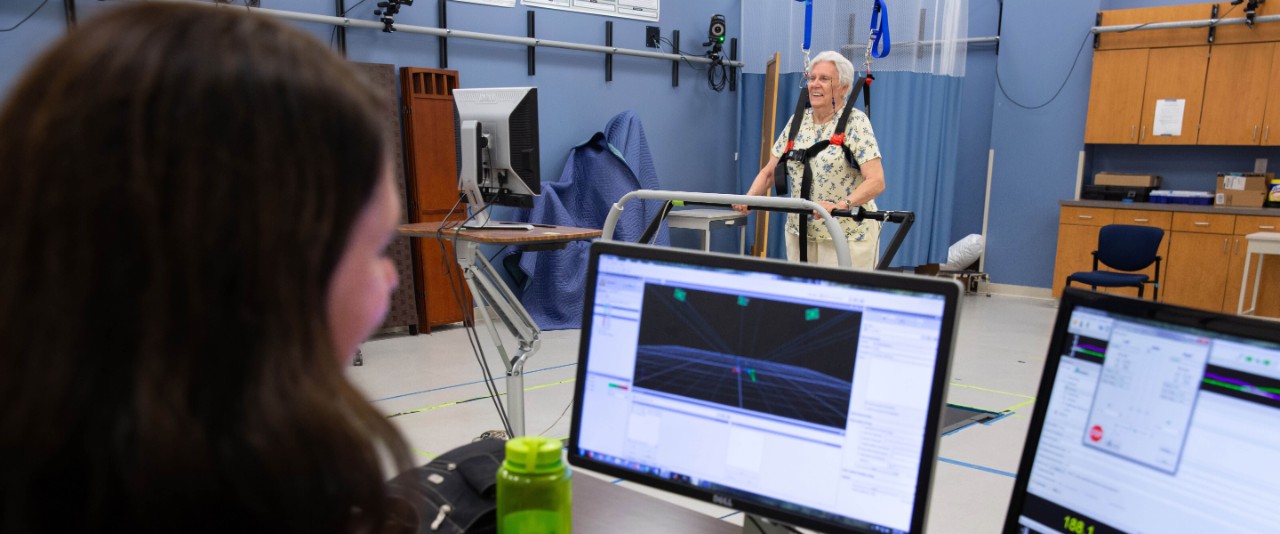
UD CLINICAL STROKE STUDIES

contact us
Kenna Gilley
You can help advance stroke therapy – Find out more about our studies!
Come in for a FREE Clinical Research Evaluation
Come in for a free Clinical Research Evaluation with a Physical Therapist. We will take a detailed look at your balance, coordination, quality of walking, and overall movement abilities. This evaluation will help us determine other research studies that you may qualify for and be interested in participating.
Stroke Studies Clinical Research Coordinator, Kenna Gilley: 302-831-3391
WHAT IS A STROKE?
A stroke is a “brain attack”. It can happen to anyone at any time. It occurs when blood flow to an area of brain is cut off. When this happens, brain cells are deprived of oxygen and begin to die. When brain cells die during a stroke, abilities controlled by that area of the brain such as memory and muscle control are lost.
How a person is affected by their stroke depends on where the stroke occurs in the brain and how much the brain is damaged. For example, someone who had a small stroke may only have minor problems such as temporary weakness of an arm or leg. People who have larger strokes may be permanently paralyzed on one side of their body or lose their ability to speak. Some people recover completely from strokes, but more than 2/3 of survivors will have some type of disability. Read more on Stroke.org.
Innovations in stroke research, education, care at UD: youtube.com/watch?v=CTVchM3FiXE
OUR STUDIES
- Treadmill Walking Studies
- Purpose: to assess locomotor function, balance, and motor learning after stroke.
- Hand-eye Coordination and Sensation
- Purpose: to understand how brain damage can affect a person's perception of where their body is in space.
- Ankle Foot Orthosis + Stroke
- Purpose: to assess best bracing options after stroke
- High-Intensity Interval Training
- Purpose: To investigate whether high-intensity treadmill walking improves walking function after stroke
- Optimal Intensity and Duration of Walking Rehabilitation in Patients With Chronic Stroke: A Randomized Clinical Trial
- Clinical Practice Guideline to Improve Locomotor Function Following Chronic Stroke, Incomplete Spinal Cord Injury, and Brain Injury
- Exercise intensity affects acute neurotrophic and neurophysiological responses poststroke
- Demystifying the Complexity of Aphasia Treatment: Application of the Rehabilitation Treatment Specification Systemx
- Impairments of the ipsilesional upper-extremity in the first 6-months post-stroke
- Differential loss of position sense and kinesthesia in sub-acute stroke
- Validating the measurement of upper limb sensorimotor behavior utilizing a tablet in neurologically intact controls and individuals with chronic stroke
- A Review of Robot-Assisted Lower-Limb Stroke Therapy: Unexplored Paths and Future Directions in Gait Rehabilitation
- Anterior fall-recovery training applied to individuals with chronic stroke
- Posterior fall-recovery training applied to individuals with chronic stroke: A single-group intervention study
ABOUT OUR RESEARCHERS
The University of Delaware Stroke Research Team is working hard to advance the science of physical rehabilitation.
Our researchers are conducting studies investigating new techniques to examine how brain damage affects performance and how to improve function after a stroke.
Volunteers who participate in our research will help us learn more about people with stroke. Our findings from these studies will help us understand how the brain works after stroke and design future rehabilitation protocols.
Our team consists of 11 Principal Investigators, Stroke Study Coordinators, and Research Physical Therapists.
- Darcy Reisman
- Susanne Morton
- Jill Higginson
- Rebecca Hunting Pompon
- Jennifer Semrau
- Elisa Arch
- Fabrizio Sergi
- Jeremy Crenshaw
- Panagiotis Artemiadis
